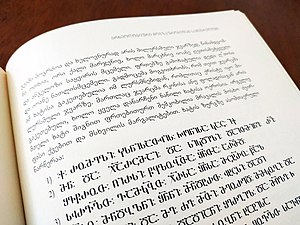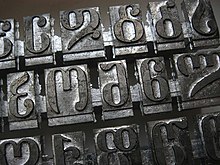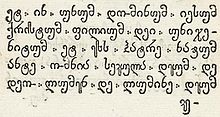Georgian scripts
The Georgian alphabet (Georgian ქართული ანბანი kartuli anbani, IPA: [kʰɑrtʰʊlɪ ɑnbɑnɪ]) is an alphabetic script in which the Georgian language has been written since at least the 5th century. The modern alphabet contains 33 letters, each of which corresponds exactly to a phoneme. Before the orthographic reform of the 19th century, there were five additional letters in the classical Georgian alphabet, which are phonetically superfluous for the new Georgian language. The direction of writing in Georgian is from left to right. The alphabetical order of the letters seems to be influenced by the Greek alphabet, although the graphic of the Georgian letters is probably not from another script and is considered an original invention.
Georgian script comprises three graphically distinct types: Assomtawruli, Nushuri and Mchedruli. Popular literature sometimes speaks of three Georgian scripts, but from a paleographic point of view they are different types of the same script: All three are also historical stages of development formed from each other and, with few exceptions, share a common alphabetical order and common letter names. According to a classification commonly used today, both for typographic purposes (e.g. coding and keyboard), Assomtawruli and Nushuri are considered upper and lower case letters of the same Chuzuri script, while Mchedruli is considered a separate script. The modern Mchedruli script does not distinguish between upper and lower case letters, but there is a Mchedruli majuscule script - the Mtawruli - which is very actively used for short texts written exclusively with majuscules. Historically, until today, all three types have always been used in parallel since the 10th century, but with different functions and dominance. Currently, Assomtawruli and Nushuri are officially used only by the Georgian Orthodox Church for ecclesiastical literature, while Mchedruli is the commonly used and dominant Georgian script.
Apart from the Georgian language, the Georgian script with some additional letters is also used for writing other South Caucasian languages - Mingrelian, Swanish and Laz - as well as for North Caucasian Bats language. From 1938 to 1954 the Georgian script was officially used for the Abkhazian and Ossetian languages. In the past, the letters were also used as numerals.

Text in Georgian Mchedruli and Assomtawruli scripts on the same page. At the top you can also see the header in the Mtawruli script.
Typography and character encoding
Fonts
The first printed Georgian-language books - a guide to the Georgian alphabet (Alphabetum Ibericum sive Georgianum cum Oratione) and a Georgian-Italian dictionary (Dittionario giorgiano e italiano) for Catholic missionaries - were published in Rome in 1629. Nikolos Choloqashvili, ambassador of King Teimuras I of Kartli-Kakheti to Italy, is considered the author of the typeface used here. However, the proportions of Georgian letters were not properly considered in this font. Later in 1708, Georgian King Vakhtang VI established the first printing house in Georgia in Tbilisi with different and high quality fonts. Some of the Georgian fonts of that time were probably created by Anthim the Iberian - a Georgian-Romanian church leader and founder of one of the first printing houses in Romania. In the years 1749-1802 the printing house of King Erekle II was active in Tbilisi. Most of the old Georgian printed original literature is published in this printing house. Artistically, the fonts of Erekle's printing house are much lower than those of Vakhtang's printing house.
In 1864, a new Georgian font was produced in Vienna based on the drawings of the Georgian writer Micheil Qipiani. According to the place of its creation, the font was called Wenuri (Georgian ვენური, "Viennese"). This font was so superior in quality to all other fonts of the time that it was the most common in Georgian publications for almost a century.
At the beginning of the 20th century there was a conviction that Georgian round letters should be modernized and in harmony with the industrial age. Thus, the angular Mchedruli letters appear on the books, posters and pictures of that time. From 1960 to 1998 there was a so-called type laboratory in Tbilisi, where artists, linguists and psychologists worked together to develop typefaces. Within the framework of the laboratory, the type designer Anton Dumbadze developed a series of typefaces. Many of the computer fonts that were later digitized and are still in use were designed by him. The most successful of them is the font "Kolcheti" (Georgian კოლხეთი), whose digital version is still most actively used in Georgian academic and artistic publications. Unlike print publications, Sylfaen, DejaVu and Segoe are the most common Georgian fonts on the Internet and for screens.
Modern Georgian fonts are found in almost all stylistic variations characteristic of Latin, such as normal, bold, italic, there are also serif and grotesque fonts.
Unicode
→ Main articles: Unicode block Georgian, Unicode block Georgian, supplement, and Unicode block Georgian, extended.
The Georgian script has been included in Unicode Standard since 1991 with the release of version 1.0. Today, Georgian characters are in three Unicode blocks. The German linguist and cartwright Jost Gippert and the US-Irish linguist Michael Everson, who developed Georgian Unicode for the Macintosh systems, played a role in the creation of the first Georgian Unicode block (U+10A0 to U+10FF), which is simply called Unicode Block Georgian and includes only the Assomtawruli and Mchedruli letters. Significant contributions were also made by Georgian type designer Anton Dumbadze and Irakli Garibashvili (not to be confused with Georgian politician Irakli Garibashvili).
In 2005, Nushuri letters appeared in Unicode in a separate group Unicode block Georgian, Supplement (U+2D00 to U+2D2F). At the same time, it was clarified that - at least in current usage - Assomtawruli and Nushuri represent upper- and lowercase letters of a two-chamber Chuzuri script, respectively. In June 2018, another group of Unicode Block Georgian, expanded, appeared, containing the Mtawruli script as the versal or majuscule letters of the Mchedruli script.

Letters for Mtawruli script developed by Anton Dumbadze

Extract from the first Georgian printed book Alphabetum Ibericum sive Georgianum cum Oratione, Rome, 1629.
Search within the encyclopedia